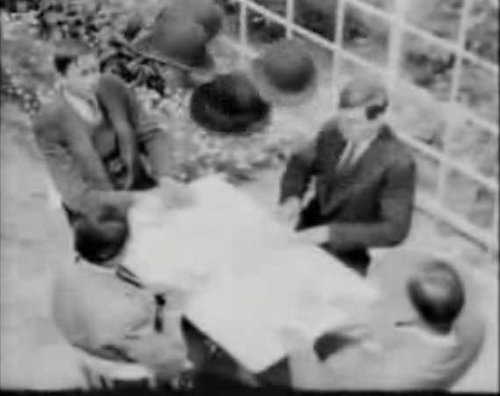Links and write-ups about beautiful things from around the web!
-
MyDsReader: Nintendo DS Text-to-Speech
MyDsReader, Nintendo DS text-to-speech document reading software for the visually impaired. It’s using the Flite synthesis engine designed for embedded devices, implements gesture controls for ease of use and even throws in an integrated email and to-do client. Excellent use of homebrew development.
(Via GameSetWatch)
-
Like the Hero of Willy Wonka and the Chocolate
Like the hero of “Willy Wonka and the Chocolate Factory,” also based on one of his books, the creatures of Dahl’s valley seem to know more than they’re letting on; perhaps even secrets we don’t much want to know. Children, especially, will find things they don’t understand, and things that scare them. Excellent. A good story for children should suggest a hidden dimension, and that dimension of course is the lifetime still ahead of them. Six is a little early for a movie to suggest to kids that the case is closed. Oh, what if the kids start crying about words they don’t know? – Mommy, Mommy! What’s creme brulee?“ Show them, for goodness sake. They’ll thank you for it. Take my word on this.
– From Roger Ebert’s review of Fantastic Mr. Fox
(Via the Ghibli Blog)
-
Hito Steyerl: In Defense of the Poor Image

The poor image is a copy in motion. Its quality is bad, its resolution substandard. As it accelerates, it deteriorates. It is a ghost of an image, a preview, a thumbnail, an errant idea, an itinerant image distributed for free, squeezed through slow digital connections, compressed, reproduced, ripped, remixed, as well as copied and pasted into other channels of distribution.
[…]
At present, there are at least twenty torrents of Chris Marker’s film essays available online. If you want a retrospective, you can have it. But the economy of poor images is about more than just downloads: you can keep the files, watch them again, even reedit or improve them if you think it necessary. And the results circulate. Blurred AVI files of half-forgotten masterpieces are exchanged on semi-secret P2P platforms. Clandestine cell-phone videos smuggled out of museums are broadcast on YouTube. DVDs of artists’ viewing copies are bartered.3 Many works of avant-garde, essayistic, and non-commercial cinema have been resurrected as poor images. Whether they like it or not.
– Excerpted from Hito Steyerl’s piece in e-flux journal #10
(Via Rhizome)
-
A biological quarter-wave retarder with excellent achromaticity in the visible wavelength region
A paper in Nature Photonics describing the waveplate mechanism found in the eye of mantis shrimp (stomatopods). These amazing critters can see hyperspectral color ranging from the infrared to the ultraviolet, can perceive different planes of circular polarized light, and have eyes that operate and dart about (saccade) independently. This paper is basically demonstrating that man-made material science has a lot to learn if we want to catch up with nature’s technology.
Personal side question: what are these shrimp on the lookout for that’s led to such a sophisticated eye??
-
Punball: Only One Earth (Modified Art Pinball)

Artist-modded classic pinball tables must be all the rage. Seen here: artist William T. Wiley’s Punball: Only One Earth, a modified version of Gottleib’s 1964 North Star table, currently on display at the Smithsonian.
(Via the Smithsonian’s Eye Level blog)
-
Laika: Processing system for Realtime Font Deformation
Michael Flückiger and Nicolas Kunz’s Laika, a Processing system for realtime font deformation based on environmental inputs.
(Via Make)
-
Pinwall: Interactive Pinball Façade
Pinwall, by Germany’s art/marketing group URBANSCREEN. Fabulous concept, but wow that’s garish! Would be fun to see some other urban architecture re-envisioned by actual pinball playfield designers. Tilt the Reichstag?
(Via Make)
-
Comptine D’un Autre Été, L’après-Midi, for Six iPhones
Yann Tiersen’s Comptine D’un Autre Été, L’après-Midi played on six iPhones. While far from a perfect, beautiful performance, I have a soft spot for this piece and it’s fun to see someone trying to overcome the limitations of the tiny virtual keyboard.
(Via SwissMiss)
-
AAAARG.ORG
A ‘conversational’ collection of academic theory and discourse on arts, aesthetics, architecture (along with other non-alliterative disicipines), a user-contributed journal. Who needs grad school?
-
Dreaming the Industrial Body

Dreaming the Industrial Body. I’m not sure that I’m following the info that they’re trying to convey about the sun’s effects on our bodies, but it’s definitely an eye-catching image as far as medical literature goes. From Der mensch gesund und krank [The Healthy and Sick Human], menschenkunde 1940 … . Vol. 2, displayed as part of the National Library of Medicine’s Dream Anatomy exhibit. Speaking of which, check out their cool children’s art page!
